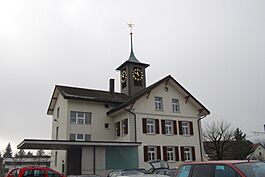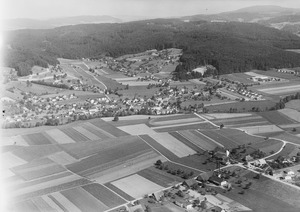Hirschthal facts for kids
Quick facts for kids
Hirschthal
|
||
|---|---|---|
 |
||
|
||
| Country | Switzerland | |
| Canton | Aargau | |
| District | Aarau | |
| Area | ||
| • Total | 3.53 km2 (1.36 sq mi) | |
| Elevation | 442 m (1,450 ft) | |
| Population
(Dec 2020 )
|
||
| • Total | 1,645 | |
| • Density | 466.0/km2 (1,206.9/sq mi) | |
| Postal code |
5042
|
|
| Surrounded by | Holziken, Muhen, Schöftland, Unterkulm | |
Hirschthal is a small town, also called a municipality, located in Switzerland. It's part of the Aargau canton, which is like a state, and is found in the Aarau district.
Contents
History of Hirschthal
Hirschthal has a long history! The first time it was ever written about was way back in the year 924. Back then, it was called Hyrztale.
Geography of Hirschthal
Hirschthal covers an area of about 3.6 square kilometers (1.4 square miles). A big part of this land, about 34%, is used for farming. Forests cover even more, around 51.5% of the area.
About 14% of Hirschthal is made up of buildings and roads where people live and travel. Only a tiny bit, 0.3%, is non-productive land like rivers or lakes. The town is located in the middle of the Suhr valley, within the Aarau district.
Hirschthal's Coat of Arms
The coat of arms for Hirschthal is quite special. It shows a red deer jumping up from a green base. The background of the shield is silver. This design is called Argent on a Base Vert a Deer salient Gules.
People and Population in Hirschthal
Hirschthal has a population of about 1,400 people. Around 8.9% of the people living here are from other countries. Over the last ten years, the number of people living in Hirschthal has grown by about 20%.
Most people in Hirschthal, about 94%, speak German. Italian is the second most common language, spoken by 1.7% of the population. Albanian is the third most common, spoken by 0.8%.
Age Groups in Hirschthal
The population of Hirschthal includes people of all ages.
- About 11.5% of the population are children aged 0 to 9 years old.
- Another 12% are teenagers between 10 and 19 years old.
- Adults aged 20 to 59 make up a large part of the population, around 57%.
- People aged 60 and older make up about 19.5% of the population.
Homes and Households
In Hirschthal, there are many different types of homes. In 2000, there were 27 homes with just one or two people living in them. There were 194 homes with three or four people. Also, 229 homes had five or more people living together. On average, each home had about 2.44 people.
In 2008, more than half of the homes, about 55.4%, were single-family houses. There were 579 homes and apartments in total.
Politics and Elections
In the 2007 federal election, the most popular political party in Hirschthal was the SVP. They received 45.2% of the votes. The next most popular parties were the SP (16.4%), the FDP (15.9%), and the CVP (5.7%).
Education in Hirschthal
People in Switzerland are generally well-educated. In Hirschthal, about 76.2% of adults aged 25 to 64 have completed higher education. This means they finished either upper secondary school or went on to university.
In the 2008/2009 school year, 111 students attended primary school in Hirschthal.
Historical Population Figures
The table below shows how the population of Hirschthal has changed over many years:
| Historical population | ||
|---|---|---|
| Year | Pop. | ±% |
| 1764 | 219 | — |
| 1850 | 581 | +165.3% |
| 1900 | 522 | −10.2% |
| 1950 | 684 | +31.0% |
| 2000 | 1,177 | +72.1% |
Economy and Jobs in Hirschthal
In 2007, the unemployment rate in Hirschthal was very low, at 1.65%. This means most people who wanted a job had one.
Hirschthal's economy is divided into three main parts:
- Primary Sector: This includes jobs like farming and forestry. In 2005, 60 people worked in this sector, with about 12 businesses.
- Secondary Sector: This involves manufacturing and construction. There were 168 people employed in this sector, working for 12 businesses.
- Tertiary Sector: This covers services like shops, offices, and healthcare. This was the largest sector, with 293 people working in 24 businesses.
In 2000, 639 people who lived in Hirschthal had jobs. Most of them, about 82.2%, worked outside of Hirschthal. However, 297 people came into Hirschthal to work. In total, there were 411 jobs available in the town that year.
Religion in Hirschthal
Based on information from the year 2000, people in Hirschthal follow different religions:
- About 22.8% of the population are Roman Catholic.
- A larger group, 60.7%, belong to the Swiss Reformed Church.
- A small number of people, about 0.34%, are part of the Christian Catholic faith.
See also
 In Spanish: Hirschthal para niños
In Spanish: Hirschthal para niños





